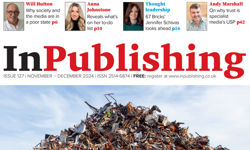Declining retail sales, increasing postal rates, uncertain economic conditions, competition from other media, and now the possibility of legislation limiting the amount of "junk mail" that can be sent out. Conditions today have never been more challenging for publishers attempting to sell subscriptions.
But, at the risk of sounding a bit like a grandfather talking about "The War", we’ve been in a similar position before. During the last century (I told you this would sound like old history) – the late 1980s and early 1990s to be specific, direct response advertising professionals came under increasing pressures, some of which are pretty much the same today. We were tasked with trying to greatly improve response rates to offset increasing mailing costs and to satisfy our advertisers’ ever increasing appetites for increased circulation.
During that time, both in the United States and here in Britain, circulation marketers went on a testing frenzy, trying anything and everything that might possibly work to boost response rates. Publishers, such as; Consumer’s Association, Reader’s Digest, Time Inc and Rodale, were particularly aggressive in pushing innovative test agendas. And we were lucky to have had a number of talented direct response advertising gurus, such as the late Dick Benson, in the US, generating ideas for us all to emulate.
We tested everything we could think of and invariably found that many of the ideas worked. Some even proved incredibly successful.
Broadly speaking, the testing we carried out can be categorised as follows: creative (design, layout and copy), list (in-house databases and rented lists) and offer (hard versus soft, gift versus non-gift, discounted versus full-price, etc). Every promotional opportunity was viewed as a chance to learn more and we often devoted as much as 30% of our direct response advertising budgets to testing. The approach was very scientific and disciplined. And our objectives ranged from trying to achieve small incremental gains in response to creating revolutionary results, doubling and sometimes quadrupling net response rates and greatly improving our recruitment economics.
And, sounding again like a grandfather, I unfortunately don’t think this level of disciplined testing is happening today as much as it did way back then, resulting in fewer big gains in the discovery of break-through and novel approaches to subscription selling. But, perhaps the return of difficult times will spur a renewed interest in looking for new ideas, or even perhaps re-visiting some of the old ones.
As mentioned above, one of the key areas of testing was that of "offer". By offer, I mean the buying proposition that’s being put forward to prospective customers.
The hard offer
Prior to the 1980s, the general offer went something like this: "subscribe to our magazine by sending us payment now for the upcoming year. We promise to send you a magazine each month." We tended to call this approach a "hard offer", and it generally relied on prospects having a good idea of what the publication was all about and in their trusting that the publisher would fulfil its obligations. As a result, response rates were typically quite low and publishers relied on low mailing costs and high product prices to make the promotions work.
An incremental improvement to this offer was the introduction of a guarantee; eg, "if you’re ever unhappy we’ll gladly refund you for all undelivered issues" or the more generous guarantee, "we’ll refund you for the entire amount you paid" (word of caution, don’t use this guarantee in your renewal promotions – the consequences are ugly, believe me!). But we’re talking small incremental response rates, not the stellar improvements the times required.
Softer options
The larger response enhancing breakthroughs came with the introduction of softer options, such as "bill me" and "risk-free" offers. These offers mirrored what was happening in other industries, where store and credit cards were allowing consumers to purchase goods without parting with cash and only providing a promise they would pay in the future.
The "hardest" of the "bill-me" offers goes as follows: "Yes, I’d like to subscribe to your publication at the price stated. Please send me an invoice, which I promise to pay." This offer, generally worth about 10% on net response improvement, with payment rates very good – upwards of 95% or so, worked quite well. The billing process could be quite simple and in the end, turning non-paying customers over to a collection agency was typical. Deadbeats had promised to pay so chasing them relentlessly was to be expected. However, net response rates, while improved over the hard, cash with order offer, still did not provide the overall lifts needed, especially for recruiting new subscribers.
‘Send no money now’ offer
A bigger breakthrough occurred with the introduction of "send no money now" offers, which provided no option to pay at all. This allowed responders to subscribe without writing a cheque, filling in bank or credit card details or having to do anything but pop the reply device in the post (often on a post card). This offer substantially increased response rates by breaking down barriers to responding. And when combining the offer with strong statements of guarantee, it worked as a harder version of a "risk-free" offer. One thing to note about using this offer – it is essential that a strong billing series is in place, not just a bog standard set of invoices but a series much more like a renewal series, that consistently re-sells the product and calls customers to action. Additionally, you can decide how much bad debt exposure you’re willing to take by limiting the number of magazines provided before suspending service, even by delaying sending any issues until customers pay.
The free gift
Another useful method for improving payment rates on this offer, as well as improving initial response too, is to offer a "free gift", or premium, that is only awarded once a customer pays. The billing series is then tied to the customer getting the gift and avoiding having their service suspended.
But the ultimate "bill-me" option is the "risk-free" offer. This offer revolutionised the way magazines were sold in the US and by US publishers operating in Britain. The offer is straightforward and ideal for publications that enjoy little brand recognition, especially new ones. Generally, the offer is stated as follows: "Yes, I’d like to try your magazine. If I like it, I’ll pay for the subscription. If not, I’ll write ‘cancel’ on the invoice and return it to you. I’ll owe nothing and the issues are mine to keep." Typically, a risk-free offer works best when paired with a free gift offer, where the gift is sent after the customer pays. And, as noted above, the billing series becomes even more important, as this offer is really a two-step selling process, removing all barriers of commitment and letting the strength of the product and the promise of the gift close the deal. The downside of the offer is that it requires the customer to decide to continue subscribing by actually making a payment.
Direct debit
Conversely, while American publishers were introducing "bill-me" and "risk-free" offers, British publishers were making headway with direct debit offers. Most notably, publishers such as Consumer’s Association and Reader’s Digest were using the pulling power of prize draws, sweepstakes and risk-free trials, to boost response rates while securing bank details for use in setting up direct debits. Responders could choose to continue their subscriptions by doing nothing or cancel by having to notify their bank or the publisher. The benefit over the American risk-free and bill-me approaches was that inertia favoured the direct debit offer. The downside, however, was that the direct debit requirement invariably dampened response rates.
At the time, we tested both the risk-free offer, combined with a prize draw, against the Consumer’s Association and Reader’s Digest approaches. Just to be sure we knew the ins and outs of direct debit offers, we hired people away from both of these publishers and enjoyed great internal debate over the merits of the different offers. Unfortunately, we were never able to beat the risk-free offer with a direct debit offer, even when considering retention over time. The upfront fall off in response was just too great and the gains in retention were just not good enough. Whether our British colleagues were also testing both approaches, I never discovered. But I would have loved to have seen their results if they had.
So, how does all of this relate to today’s subscription selling environment? Perhaps it doesn’t at all. But if I were starting over today, I’d be dusting off all these "old" offers and testing them vigorously and with great discipline. I’m just not convinced that the typical "hard", direct debit offers being used today by most publishers are really the best options for exploiting subscription selling opportunities and improving subscription economics. And when I have seen "risk-free" being used, it seems to be offered to the wrong set of consumers. For instance, to retail customers, which surely is damaging newstrade sales in that product is being given away to people who are already buying – again, the best use of risk-free is to people not already buying your magazines and possibly not likely to do so unless prompted.
And again, I’d challenge publishers to test their use of direct debit very carefully. Direct debit is a great tool for securing renewals over time but I remain dubious about its usefulness in recruiting new readers. Fortunately, there’s a great way to find out – start testing! If you learn anything new, give me a shout.
FEATURE
Billing strategies to boost response
When devising your new subscriber acquisition strategies, the presentation of the offer is critically important. Offer types range from the hard, money-up-front to the soft risk-free, bill-me-later, with multiple variations in between. Greg Harris talks us through the various options.










